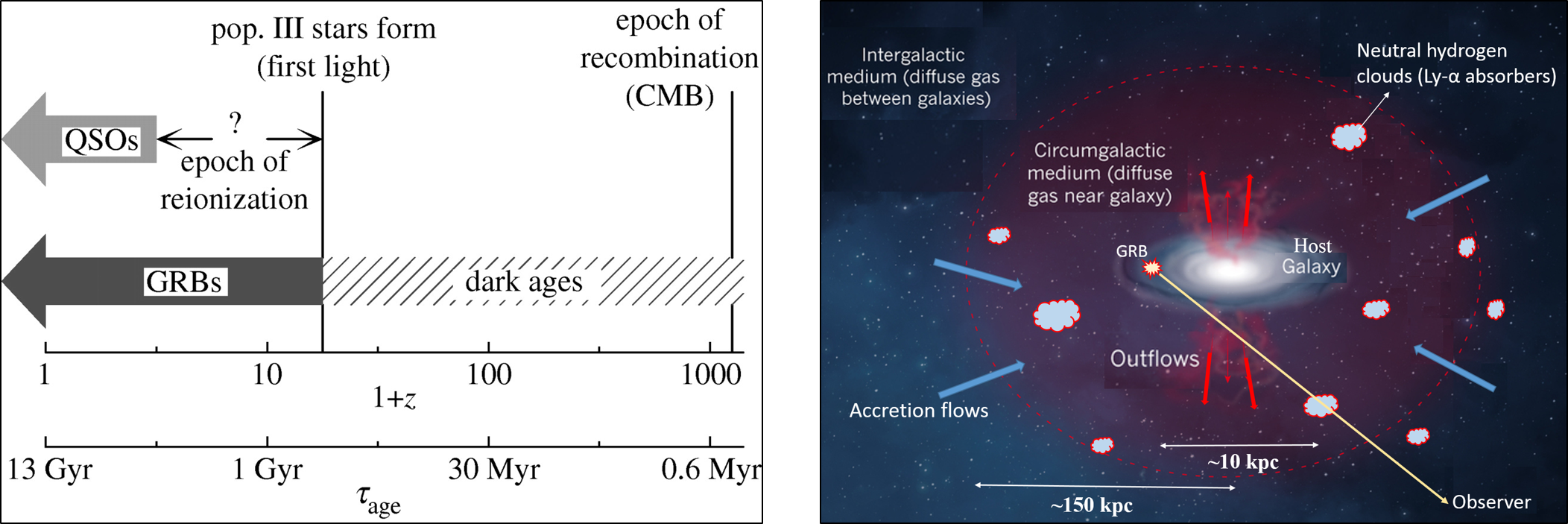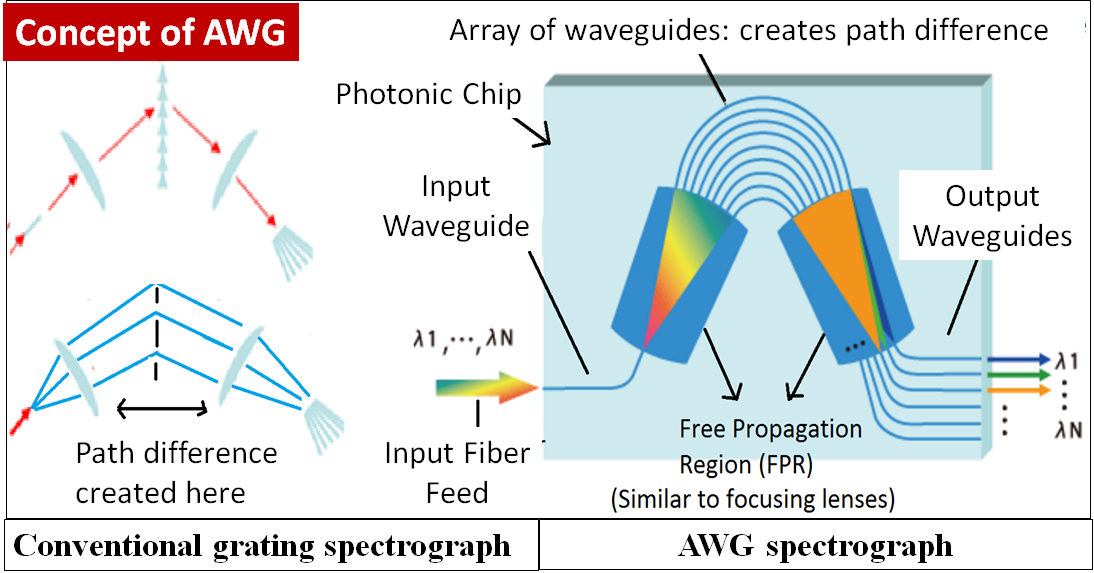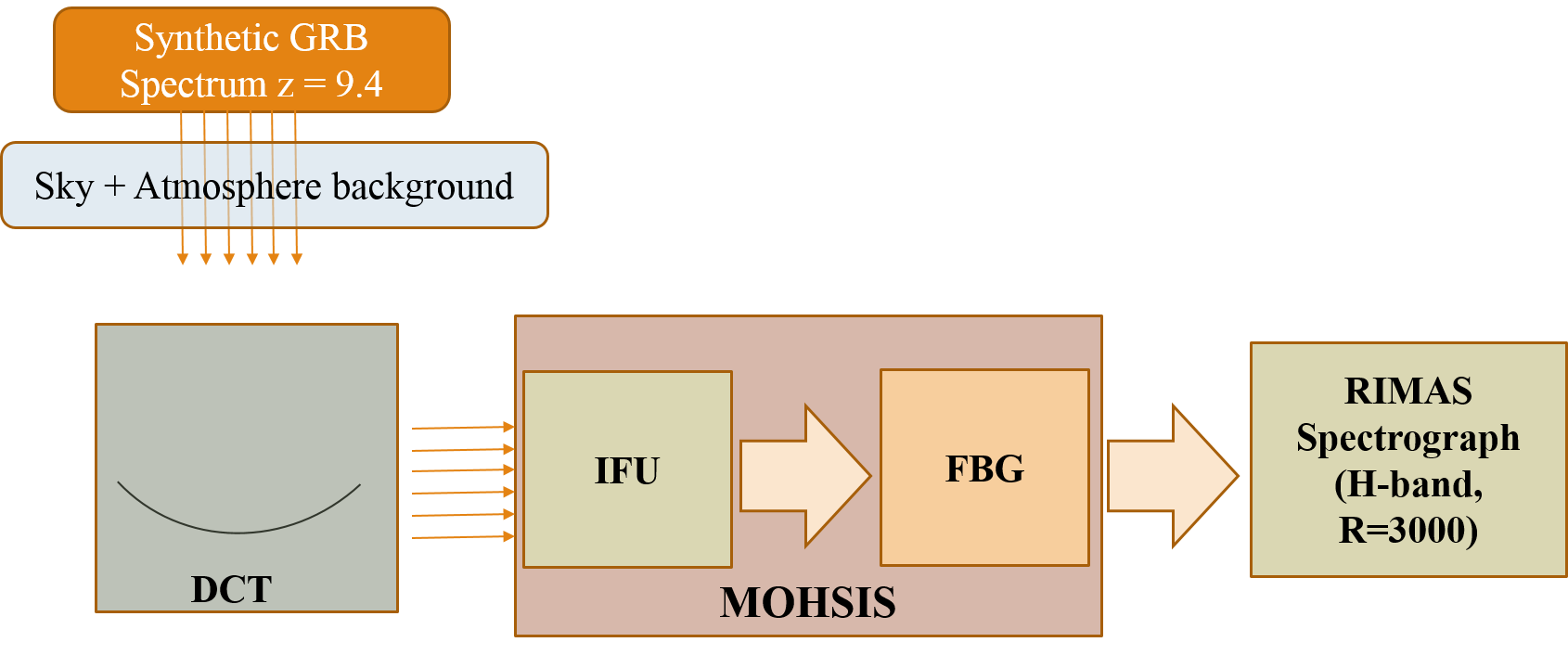Recent Projects ....
1. Gamma-Ray bursts as the probes of early universe
Gamma-ray bursts (GRBs) are bright flashes peaking in gamma-ray releasing as much energy in a few seconds as the sun over a course of its 10-billion-year lifetime. GRB afterglows have been detected from low redshift ∼0.01 out to redshift of 8.2 (Tanvir et al. 2009), thus probing all the way back to the first billion years of the universe . The prompt gamma-ray emission is followed by a multiwavelength synchrotron afterglow lasting a few days. The prompt discovery and localization of GRBs, thanks to NASA's Swift mission, has allowed a rapid follow-up of the afterglows with ground-based telescopes. The afterglow spectra harbor absorption features produced by the material along the line-of-sight (host galaxy, circumgalactic medium and intergalactic medium), The ions (at low and high ionized state) provide an excellent opportunity to explore the GRB Host galaxy environment, the excitation mechanism of these lines, metallicity and dust content. I particularly study the circumgalactic medium, residing at the nexus of accretion flows, galactic winds and outflows. I use the high-resolution spectra of GRB afterglows to study the kinematics of these feedback mechanisms of GRB hosts and their evolution as a function redshift.
 |
Relevant Publications:
2. Development of an Astrophotonic Spectrometer in near-IR
Astrophotonics is an exciting new field marking the synergy between the science of astronomy and the photonics technology. The cost and size of conventional astronomical instruments scale as volume of the telescope (i.e. cube of the telescope diameter). But the advent of astrophotonics has opened up avenues to massively miniaturize astronomical spectrographs and reverse the cost and size spiral. At The Maryland Astrophotonics Laboratory, we are developing the first-generation of miniature near-IR imaging spectrometer built entirely from small-scale integrated photonic devices, miniaturizing the spectrometer to the size of a shoe-box. At its heart is the concept of Arrayed waveguide gratings, which allows fine tuning of path lengths of individual light channels to get constructive intereference peaks at precise locations, within a few nanometers. All of this photonic action happens on a tiny chip (~ 1cm x 1cm) that we fabricate in the Nano-fablab at UMD. The AWG spectrometer device covers H-band in near-infrared (1450-1650 nm) with a moderate wavelength-resolution (1nm) and on-chip throughput of 65%.
Currently at Caltech, I am working on expanding the operational waveband to the J-band (1100-1450 nm) as well as increasing the resolving power of the AWG (R ~ 10,000) to make them ready for future investigations of exoplanet atmospheres and galaxies.
 |
Relevant Publications:
Press release: Best student presentation award at SPIE Astronomical Instrumentation + Telescopes, Edinburgh, UK
3. Atmospheric OH-suppression to aid the study of Intergalactic Medium (IGM)
For ground-based telescopes, atmospheric-OH emission lines lead to a bright background in near-infrared, thus greatly reducing signal-to-noise ratio (SNR) for faint objects such as distant GRB afterglows. The photonic technology of Fiber Bragg Gratings (FBGs) have been recently demonstrated to significantly reduce the NIR background by blocking the OH-emission lines without significantly affecting the interline continuum. I have simulated the performance of fiber Bragg gratings (FBGs) in H- and J-band (1100-1700nm) using a a detailed model of sky background, atmospheric background and emission as well as instrument pipeline. Specifically, I simulated FBGs applied to the RIMAS spectrograph (Rapid Infrared Imager Spectrometer, a joint effort of UMD astronomy and NASA GSFC) on the 4.3m Discovery Channel Telescope (DCT). We call this suit of instruments MOHSIS (Maryland OH Suppression IFU System). The simulations are aimed towards evaluating the utility of OH-suppressing FBGs for detecting and measuring 1) diagnostic metal absorption-lines of GRB hosts and 2) the damped wings of Lyman-alpha absorption in high-redshift GRB afterglows to constrain 1) the host metallicity and 2) epoch of reionization of the universe respectively. The preliminary results show an estimated ten-fold improvement in signal-to-noise ratio.
 |
Relevant Publication: